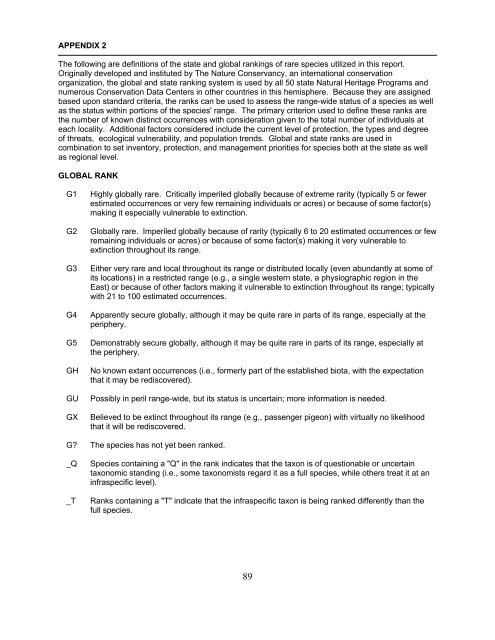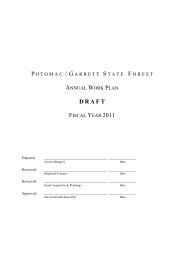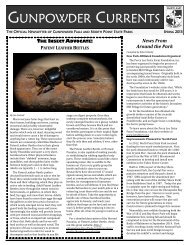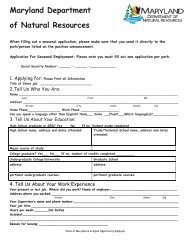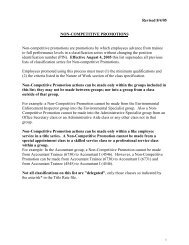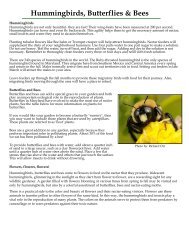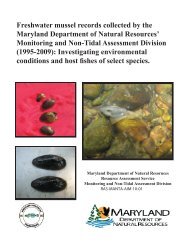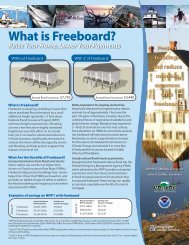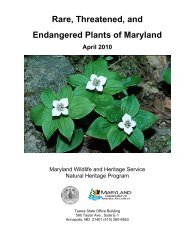tidal hardwood swamps - Maryland Department of Natural Resources
tidal hardwood swamps - Maryland Department of Natural Resources
tidal hardwood swamps - Maryland Department of Natural Resources
You also want an ePaper? Increase the reach of your titles
YUMPU automatically turns print PDFs into web optimized ePapers that Google loves.
APPENDIX 2<br />
The following are definitions <strong>of</strong> the state and global rankings <strong>of</strong> rare species utilized in this report.<br />
Originally developed and instituted by The Nature Conservancy, an international conservation<br />
organization, the global and state ranking system is used by all 50 state <strong>Natural</strong> Heritage Programs and<br />
numerous Conservation Data Centers in other countries in this hemisphere. Because they are assigned<br />
based upon standard criteria, the ranks can be used to assess the range-wide status <strong>of</strong> a species as well<br />
as the status within portions <strong>of</strong> the species' range. The primary criterion used to define these ranks are<br />
the number <strong>of</strong> known distinct occurrences with consideration given to the total number <strong>of</strong> individuals at<br />
each locality. Additional factors considered include the current level <strong>of</strong> protection, the types and degree<br />
<strong>of</strong> threats, ecological vulnerability, and population trends. Global and state ranks are used in<br />
combination to set inventory, protection, and management priorities for species both at the state as well<br />
as regional level.<br />
GLOBAL RANK<br />
G1 Highly globally rare. Critically imperiled globally because <strong>of</strong> extreme rarity (typically 5 or fewer<br />
estimated occurrences or very few remaining individuals or acres) or because <strong>of</strong> some factor(s)<br />
making it especially vulnerable to extinction.<br />
G2 Globally rare. Imperiled globally because <strong>of</strong> rarity (typically 6 to 20 estimated occurrences or few<br />
remaining individuals or acres) or because <strong>of</strong> some factor(s) making it very vulnerable to<br />
extinction throughout its range.<br />
G3 Either very rare and local throughout its range or distributed locally (even abundantly at some <strong>of</strong><br />
its locations) in a restricted range (e.g., a single western state, a physiographic region in the<br />
East) or because <strong>of</strong> other factors making it vulnerable to extinction throughout its range; typically<br />
with 21 to 100 estimated occurrences.<br />
G4 Apparently secure globally, although it may be quite rare in parts <strong>of</strong> its range, especially at the<br />
periphery.<br />
G5 Demonstrably secure globally, although it may be quite rare in parts <strong>of</strong> its range, especially at<br />
the periphery.<br />
GH No known extant occurrences (i.e., formerly part <strong>of</strong> the established biota, with the expectation<br />
that it may be rediscovered).<br />
GU Possibly in peril range-wide, but its status is uncertain; more information is needed.<br />
GX Believed to be extinct throughout its range (e.g., passenger pigeon) with virtually no likelihood<br />
that it will be rediscovered.<br />
G? The species has not yet been ranked.<br />
_Q Species containing a "Q" in the rank indicates that the taxon is <strong>of</strong> questionable or uncertain<br />
taxonomic standing (i.e., some taxonomists regard it as a full species, while others treat it at an<br />
infraspecific level).<br />
_T Ranks containing a "T" indicate that the infraspecific taxon is being ranked differently than the<br />
full species.<br />
89


